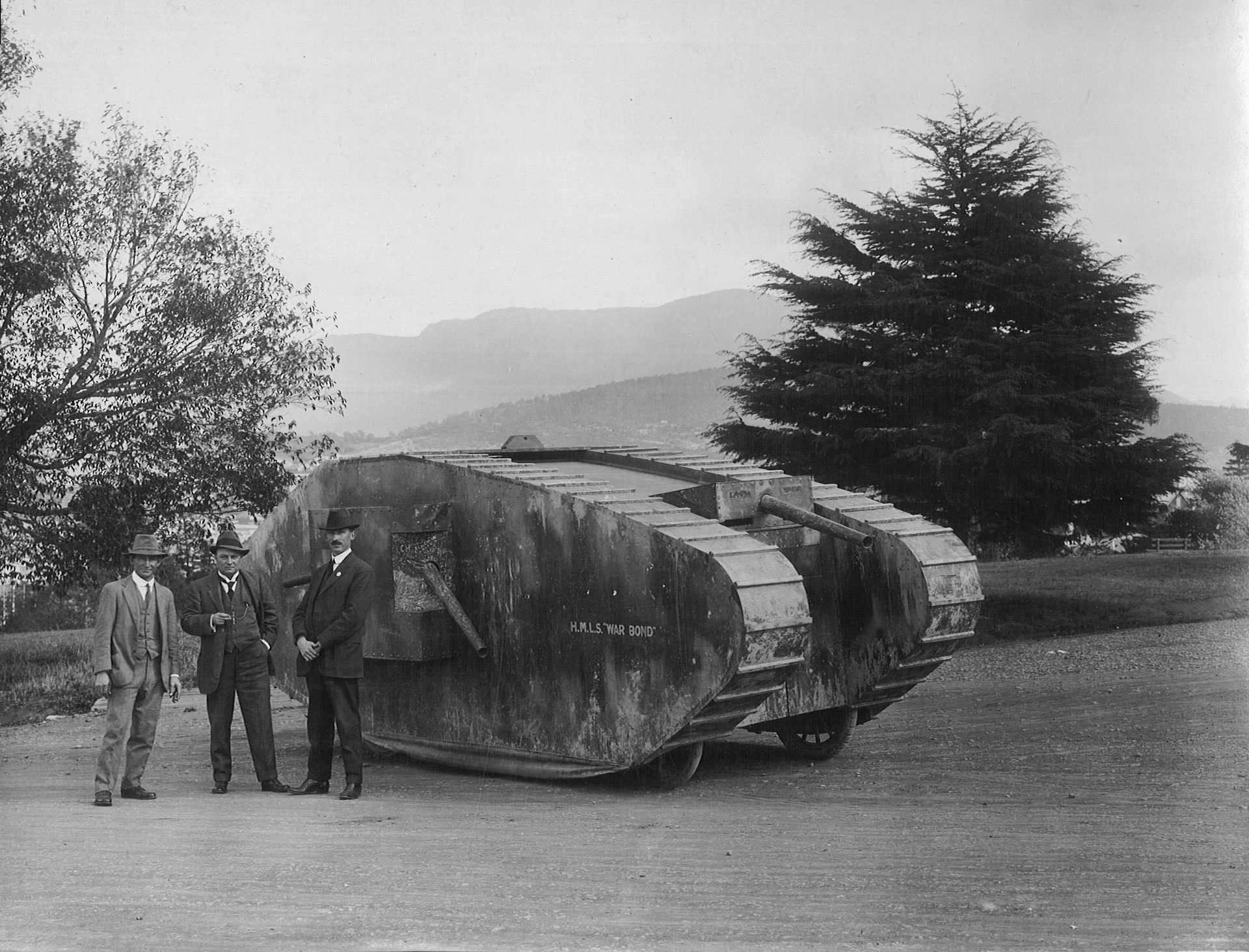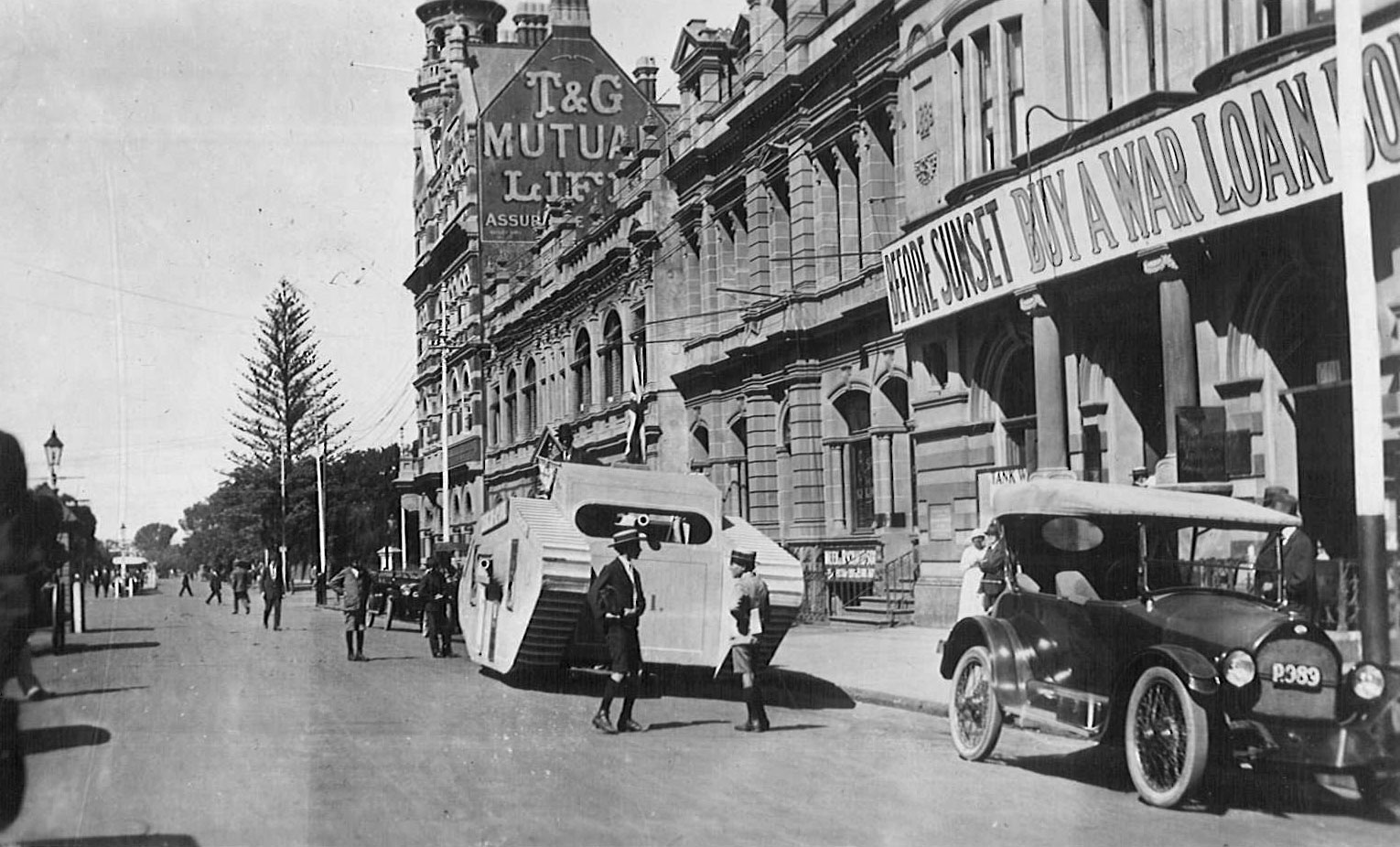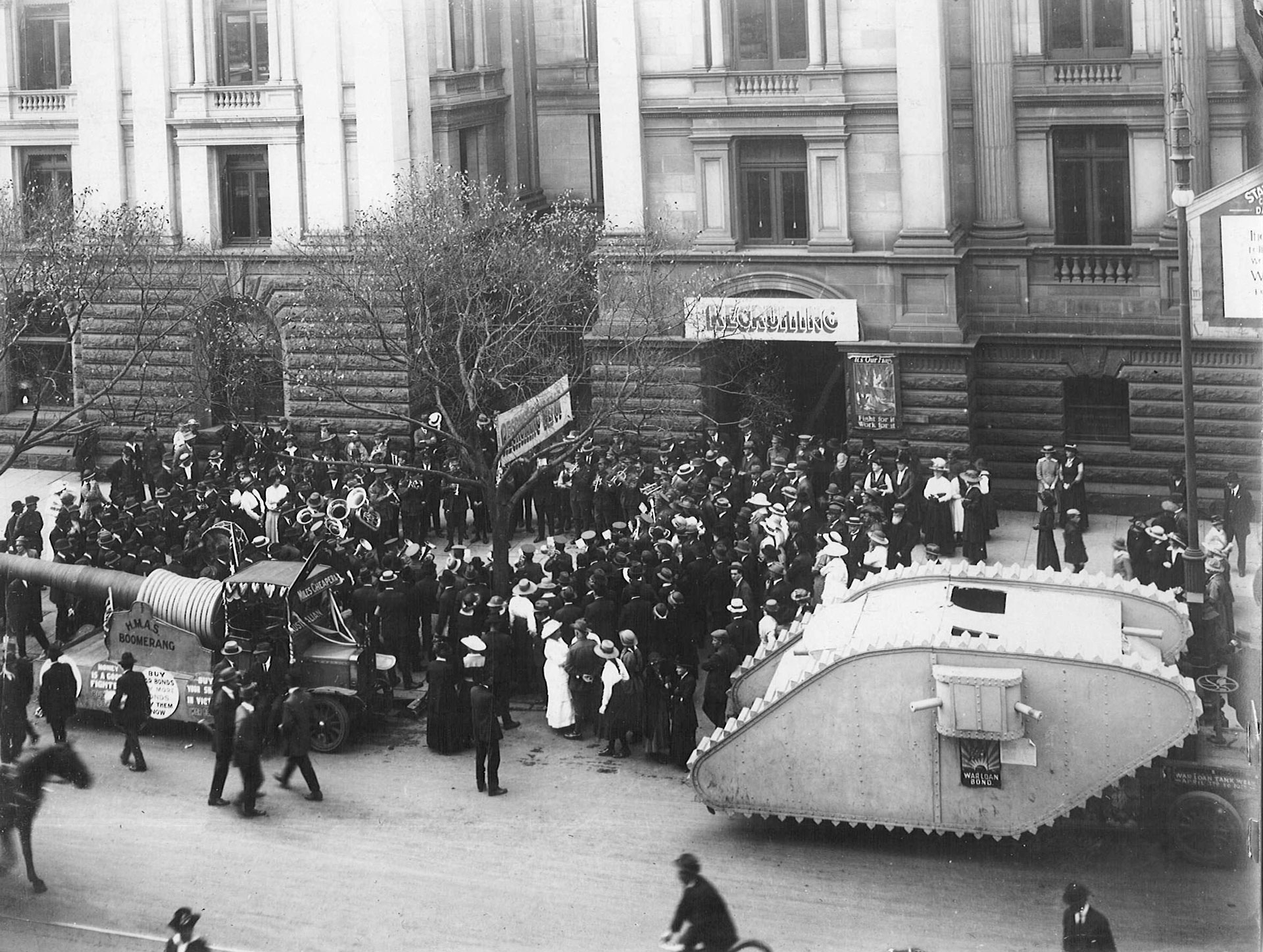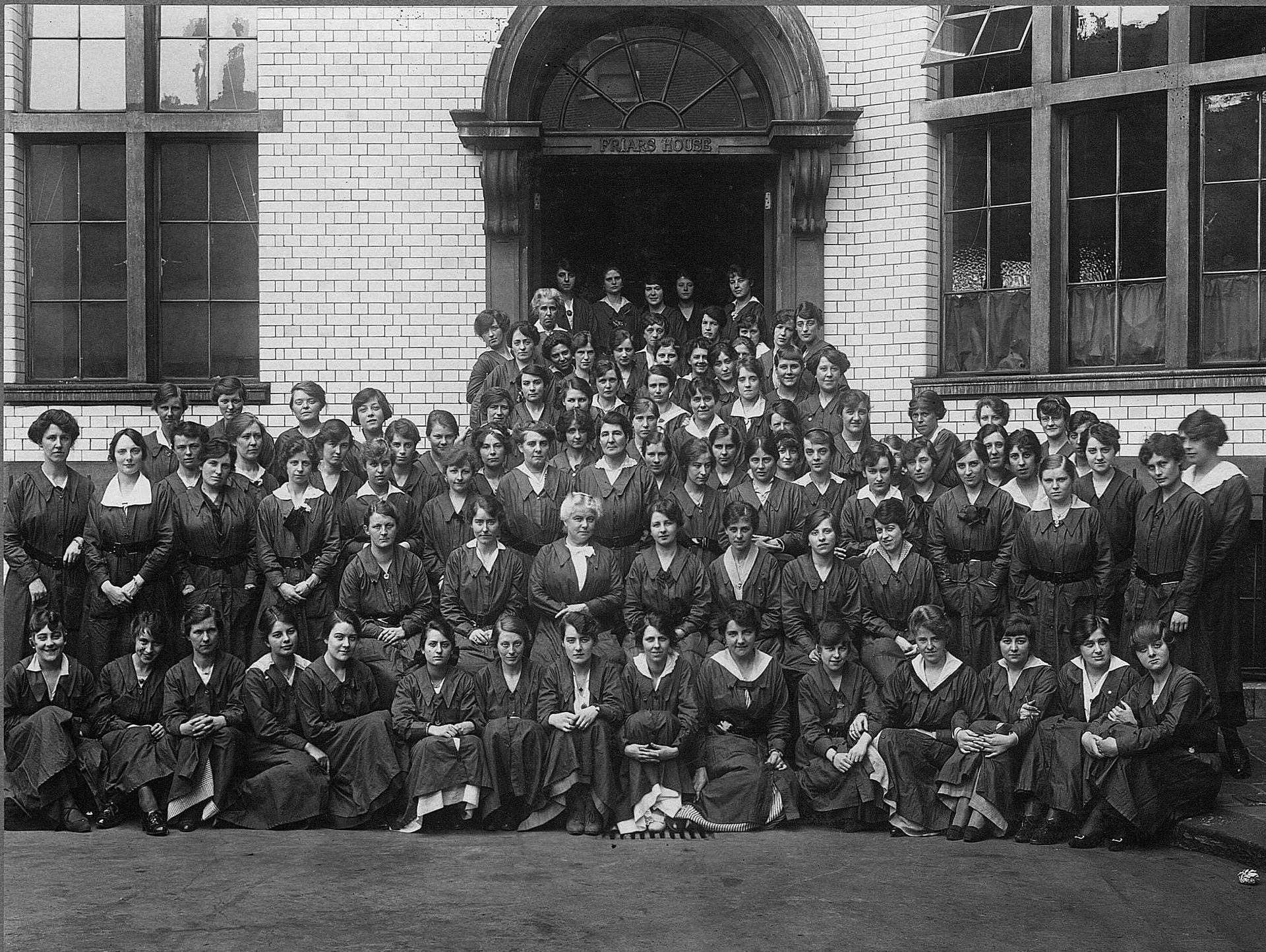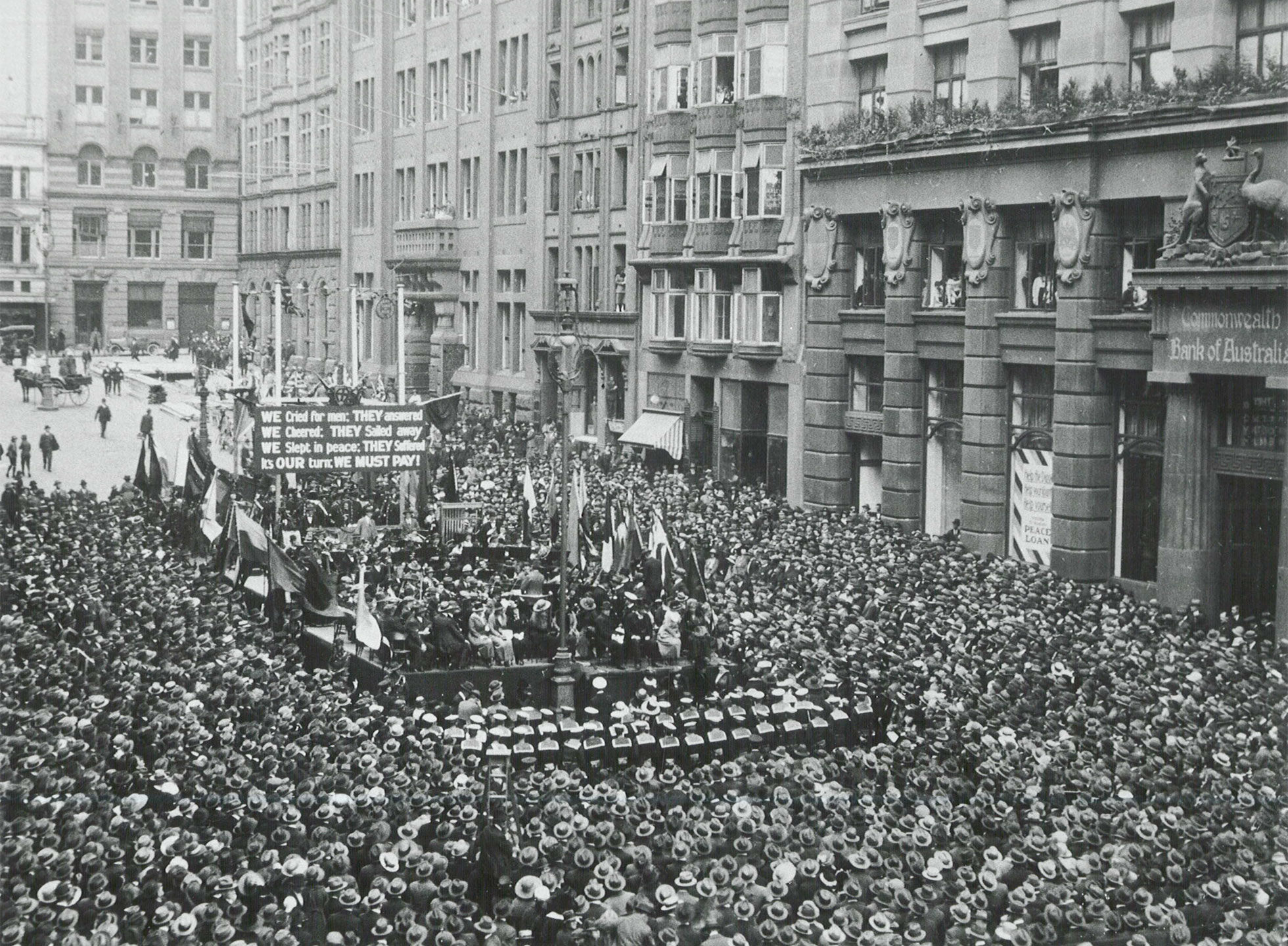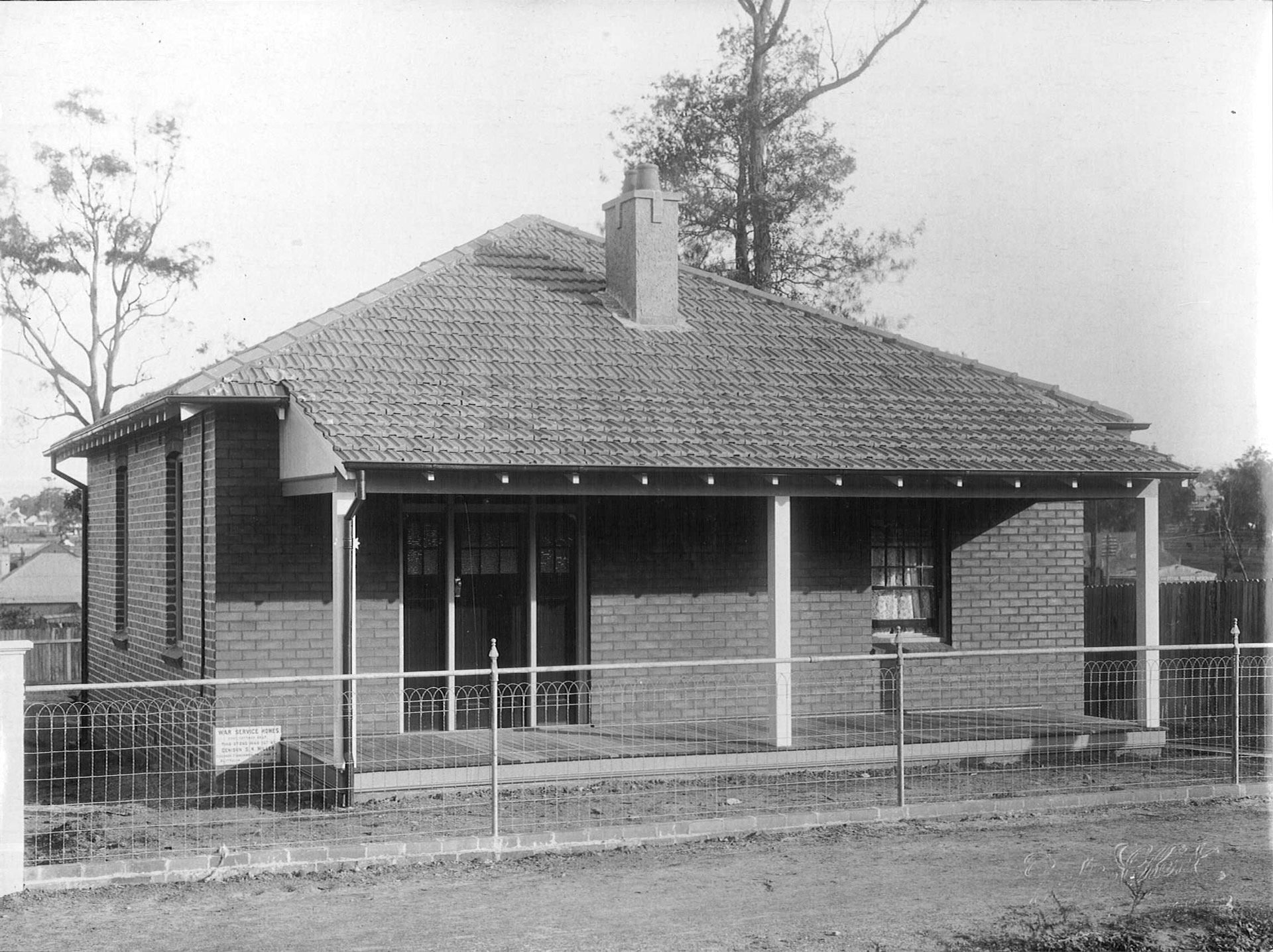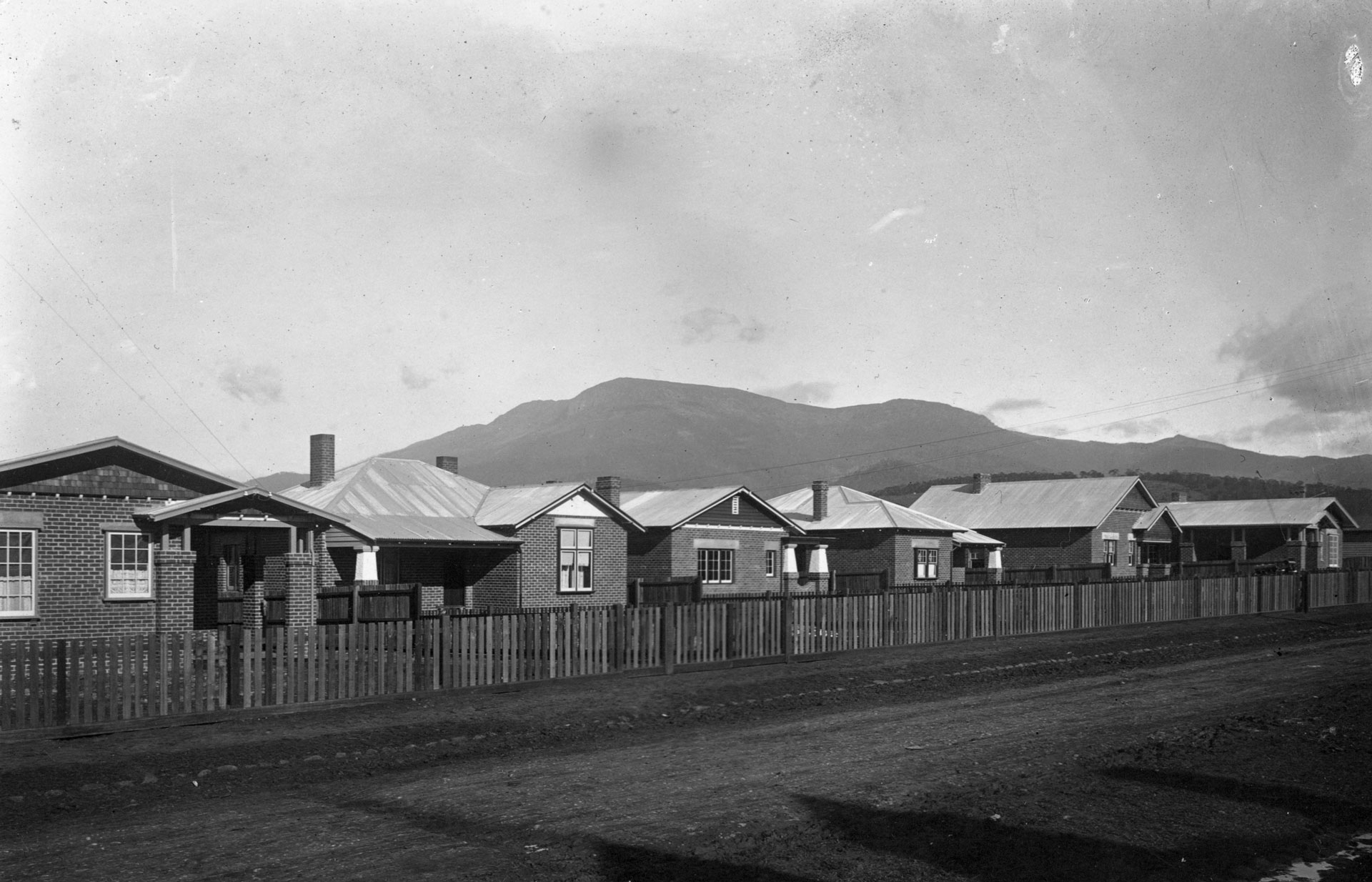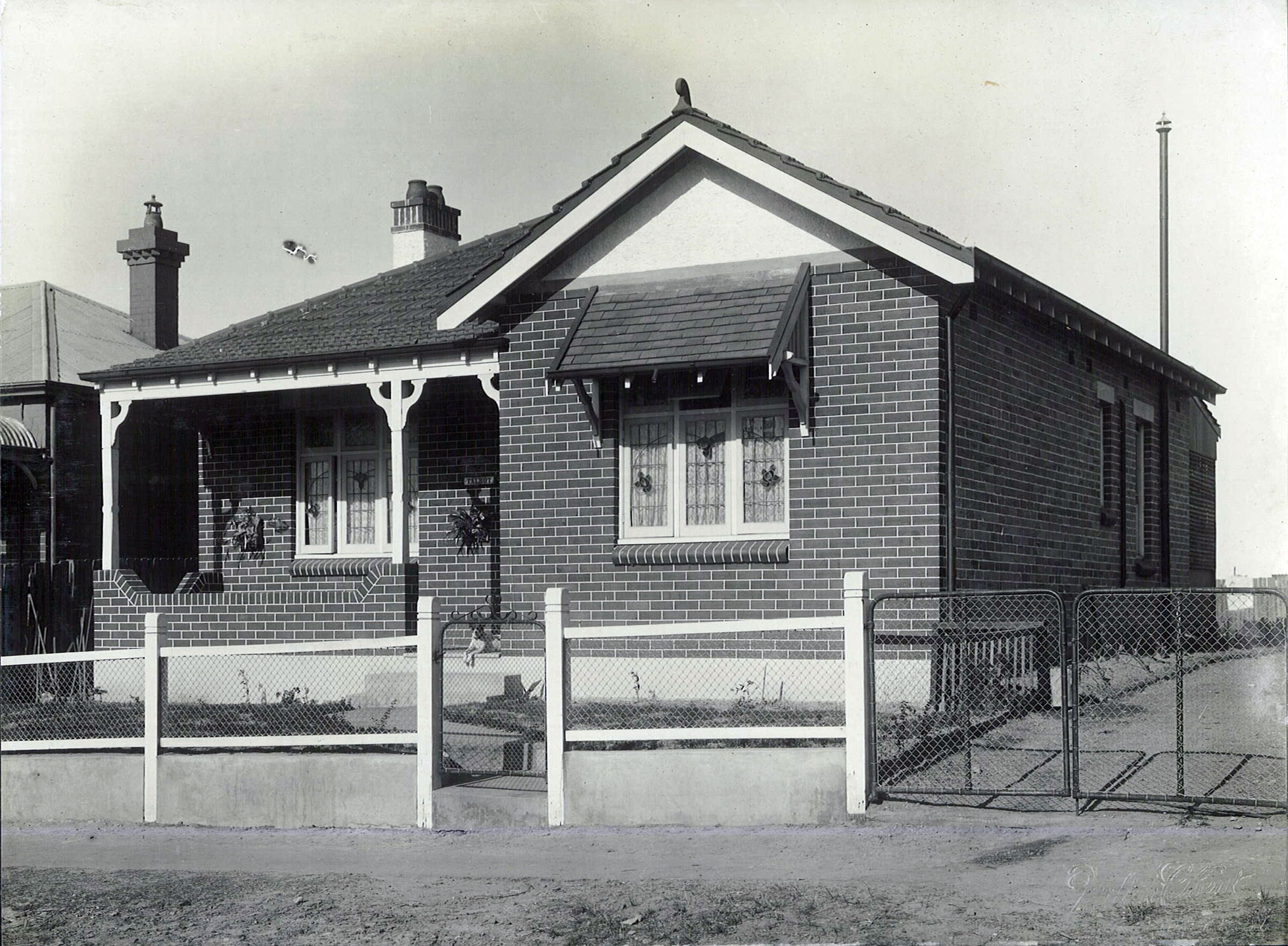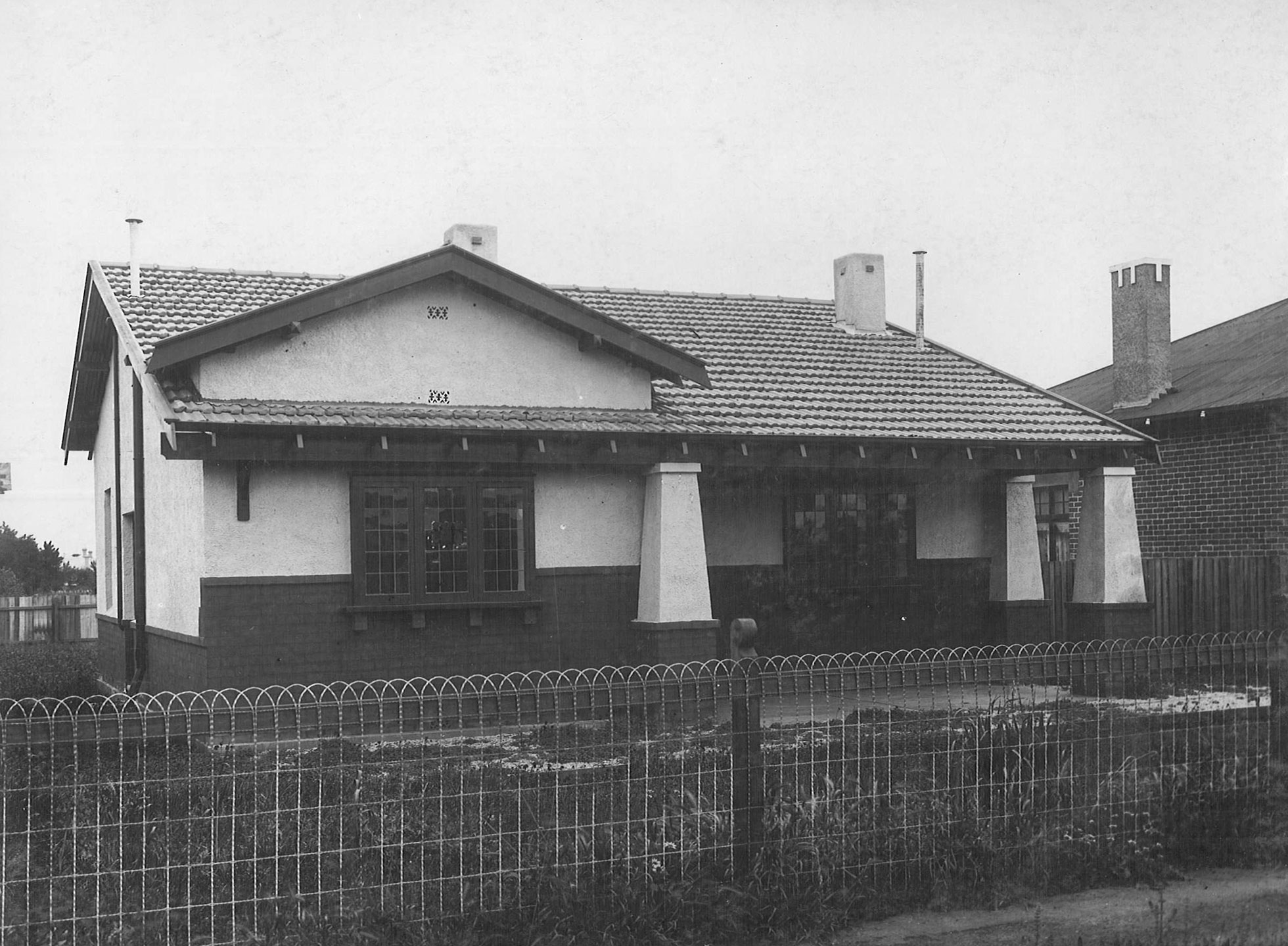From Bank to Battlefield
Gallery
This selection of photographs from the Reserve Bank of Australia's archives documents aspects of the building of the Bank's head office, and the Bank's involvement in raising funds through the sale of War Loan Bonds, and then Peace Loan Bonds after the war's conclusion. During this period, the Bank had a role as the government printer and had an official photographer who documented scenes in the nation's financial life.
Establishing the Bank
Upon becoming the Bank's Governor in 1912, Denison Miller decided that Sydney, the largest city in the Commonwealth, should be the site of the head office. A site on the corner of Pitt Street and Moore Street (now Martin Place) was purchased for £93,000 by the Commonwealth Government on 23 October 1912.
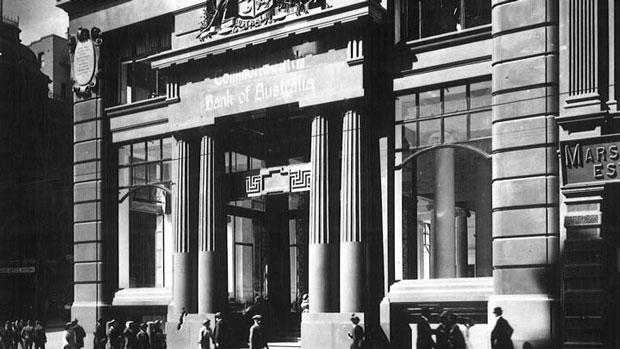
The Laying of the Foundation Stones
The foundation stones for the head office were laid on 14 May 1913. Equipped with a gold trowel, the Prime Minister and Commonwealth Treasurer, Andrew Fisher, and the Bank's Governor, Denison Miller, each laid a foundation stone.
Temporary premises of the Commonwealth Bank of Australia, 3 Moore Street (now Martin Place), Sydney, 13 January 1913. The building was occupied from 1913 to 26 January 1914 when it was demolished to make way for the construction of the Bank’s head office. PN-000497
Prime Minister Andrew Fisher calls for three cheers at the ceremony for the laying of the foundation stones for the Commonwealth Bank of Australia’s head office, Sydney, 14 May 1913. P14/9948
Crowds arriving at the ceremony for the laying of the foundation stones for the Commonwealth Bank of Australia’s head office, Sydney, 14 May 1913. P14/9951
Premier of New South Wales James McGowen presents a gold trowel to the Bank’s Governor, Denison Miller, as part of the ceremony for the laying of the foundation stones for the Commonwealth Bank’s head office, Sydney, 14 May 1913. PN-000835
Premier of New South Wales James McGowen presents a gold trowel to the Bank’s Governor, Denison Miller, as part of the ceremony for the laying of the foundation stones for the Commonwealth Bank’s head office, Sydney, 14 May 1913. PN-000836
Construction Begins
During his travels to England, Europe and the United States, the Bank's Governor, Denison Miller, studied the architecture of the banks and returned with ideas for the design of the building, which he communicated to the building's architect, John Kirkpatrick.
Construction of the Commonwealth Bank of Australia’s head office, Sydney, 3 August 1914, the day before World War I was declared. Although the foundation stone was laid in May 1913, construction did not begin until later in 1914. PN-000610
Construction of the Commonwealth Bank of Australia’s head office, Sydney, 10 September 1914. PN-000613
Construction of the Commonwealth Bank of Australia’s head office, Sydney, showing masonry on the Moore Street (now Martin Place) side of the Bank, 11 January 1915. PN-000639
Messrs JP Gibson, J Jeffrey, engineer HG Kirkpatrick and building contractor H Phippard ascending in a wooden bucket to view the construction of the Commonwealth Bank of Australia’s head office, Sydney, 11 March 1915. PN-000651
View of the construction of the Commonwealth Bank of Australia’s head office, Sydney, with a man ascending on a steel beam in the background, 12 March 1915. PN-000659
The Bank’s Governor Denison Miller with the Lord Mayor and Aldermen of City Council visiting the construction site of the Commonwealth Bank of Australia’s head office, Sydney, 12 April 1915. PN-000826
Reaching 150 feet
The new 10-storey structure rose to the full height allowed by the Height of Buildings Act 1912 (NSW), which prohibited the construction of any building higher than 150 feet. The building was one of the first large-scale, steel-framed skyscrapers in Australia.
Erection of the flagpole on the roof of the Commonwealth Bank of Australia’s head office, 12 April 1916, looking across to the clock tower of the General Post Office, Sydney. PN-000798
View of the roof of the Commonwealth Bank of Australia’s head office under construction, 22 April 1915, looking across to the clock tower of the General Post Office, Sydney. PN-000670
Construction of the roof of the Commonwealth Bank of Australia’s head office, looking towards George Street, Sydney, 8 May 1915. PN-000679
View from the roof of the Commonwealth Bank of Australia’s head office during the construction, looking towards Sydney Harbour, 20 November 1915. PN-000754
Construction of the Commonwealth Bank of Australia’s head office as seen from the General Post Office clock tower on Pitt Street, Sydney, 20 August 1915. PN-000707
Construction of the Commonwealth Bank of Australia’s head office, as viewed from Moore Street (now Martin Place), Sydney, April 1915. PN-000675
Construction of the Commonwealth Bank of Australia’s head office, as seen from Moore Street (now Martin Place), Sydney, 9 November 1915. PN-000756
Construction of the Commonwealth Bank of Australia’s head office nearing completion, Sydney, 23 February 1916. PN-000784
The Opening
The building's opening on 22 August 1916 was a remarkable occasion, with crowds amassing in Martin Place for the ceremony. During the years of World War I and its aftermath, the head office became the setting for successful campaigns to raise funds, so consolidating the Bank's role as a national institution and its association with patriotism in the minds of Australians.
The opening of the Commonwealth Bank of Australia’s head office, Martin Place, Sydney, 22 August 1916. In the background, a sign on the façade of a building on George Street reads ‘Enlist the Empire Calls’. PN-000842
Crowds gather for the opening of the Commonwealth Bank of Australia’s head office, Martin Place, Sydney, 22 August 1916. In the background, a sign on the façade of a building on George Street reads ‘Enlist the Empire Calls’. PN-000850
Prime Minister Billy Hughes addresses the public at the opening ceremony of the new Commonwealth Bank of Australia’s head office, Martin Place, Sydney, 22 August 1916. PN-000853
Reception for staff in the Luncheon Hall at the opening of the new Commonwealth Bank of Australia’s head office, Sydney, 23 August 1916. PN-001433
Pitt Street façade of the completed Commonwealth Bank of Australia’s head office, Sydney, 15 September 1916. PN-003136
Funding the War Effort
Early in 1915, the British Government began to feel the financial pressure of the war and indicated to the Australian Government that it would need to finance its own share of the war effort. The Government decided to raise loans from the public, and the Commonwealth Bank was entrusted with the task of managing the operation on behalf of the Commonwealth Government.

Early War Loan Campaigns, 1915–1917
On the 1 July 1915, the first of seven war loans was launched with the Government hoping to raise £5 million. Public enthusiasm for the war effort was so great that the sum received at the close of the first loan was more than £13 million. The success of the first loan was achieved by a general newspaper appeal, but with the second loan, launched on 1 December 1915, a circular was posted to every resident in Australia who had an income of £300 or more per year, urging their support.
With the third loan of 1 June 1916, a more vigorous appeal was made to attract smaller subscribers. Only six months after the third loan appeal, a fourth was opened on 23 December 1916. The fifth war loan began on 6 September 1917. Dubbed the ‘Liberty Loan’, the title linked Australia with the United States and its name for loan campaigns.
A crowd of subscribers at the closure of the First War Loan, Commonwealth Bank of Australia branch, Stanway House, King Street, Sydney, 31 August 1915. PN-004048
Temporary War Loan Branch at the Commonwealth Bank of Australia in Dalton’s Building, Pitt Street, Sydney, 1916, possibly during the Third War Loan. The branch was opened to cater for the enormous increase in work. PN-001691
Interior of the Melbourne War Loan Department on Collins Street, Melbourne, as crowds of civilians and soldiers queue to apply for the Third War Loan, 1 August 1916. PN-001722
Entrance to the War Loan Office in the Post Office Chambers during the Fifth War Loan campaign, Sydney, October 1917. A large banner hung prominently over the entrance and read: ‘Will you help to turn the Scale? Subscribe to the War Loan. The Closing Date is Nov. 2nd – And Germany is Watching’. PN-001694
Closing Day of the Fifth War Loan at the War Loan Office, Post Office Chambers, Sydney, 2 November 1917. PN-001701
The Commonwealth Bank of Australia staff raised money for parcels sent to staff members on active service. ‘The “Gunyah”’, outside the Bank’s head office in Moore Street (now Martin Place), Sydney, acted as a home for their charitable efforts, 30 November 1917. PN-001506
Commonwealth Bank of Australia staff members raising money at the first ‘Hospital Saturday Fund’, outside the Commonwealth Bank head office in Moore Street (now Martin Place), Sydney, 1917. The money raised on Hospital Saturdays helped to support local hospitals. PN-001503
‘Before Sunset’: The Sixth War Loan Campaign, and Tank Week, 1918
The sixth war loan was launched on 17 February 1918. As in other countries of the British Empire, tanks were used to demonstrate advances in military technology, and to attract money for the war effort. ‘Tank Week’ was held from 3 to 10 April 1918. Sir Walter Davidson, the Governor of New South Wales, opened the week outside the Commonwealth Bank's head office, delivering his address from an observation platform on a model tank.
Lindsay Goulding, dressed as a war bond with the slogan ‘Before Sunset Buy a War Loan Bond’. He won first prize for the most original costume at a Red Cross fete in Northwood, Sydney, in March 1918. PN-001670
Alderman James Joynton Smith, Lord Mayor of Sydney, making the first War Loan Bond application of £10,000 on the opening day of the Sixth War Loan, 18 February 1918. He is attended by Thomas Huggins Nesbitt, Town Clerk, to the left, and the Bank’s Governor, Denison Miller, on the right. PN-001734
The Commonwealth Bank of Australia’s head office, Moore Street (now Martin Place), Sydney. The building displays a banner (‘Before Sunset Buy A War Loan Bond’) encouraging the public to subscribe to the Sixth War Loan campaign, 1918. PN-001624
Advertisements for the Sixth War Loan displayed prominently on the Commonwealth Bank of Australia’s façade, Moore Street (now Martin Place), Sydney, April 1918. PN-001623
The Governor of New South Wales, Sir Walter Davidson, opens Tank Week outside the Commonwealth Bank of Australia’s head office, Moore Street (now Martin Place), Sydney. Sir Davidson’s address was followed by speeches from David Storey, Acting Minister for Public Health, and the Lord Mayor of Sydney, Alderman James Joynton Smith. The tank is a model of the Mark IV. PN-001740
A Commonwealth Bank officer accepts a subscription for the Sixth War Loan in Moore Street (now Martin Place), Sydney during Tank Week, 3–10 April 1918. PN-001744
A subscription is made during Tank Week, 3–10 April 1918, outside the head office of the Commonwealth Bank of Australia, Moore Street (now Martin Place), Sydney. PN-001745
Opening of Tank Week, 3–10 April 1918, in Moore Street (now Martin Place), with the Lord Mayor of Sydney, Alderman James Joynton Smith, making his opening appeal to the crowds. PN-001742
Tanks in Sydney's Suburbs
As part of the sixth war loan campaign, model tanks toured to Sydney's suburbs, including Balmain, Bondi, Mosman, Newtown, North Sydney, Randwick and Redfern.
Tank Week in Mosman, Sydney, 8 April 1918, with the Mayor of Mosman, Alderman AD Walker, speaking from the top of the model tank. £33,920 was raised from the suburb. PN-001753
Redfern Town Hall, Pitt Street, Redfern, Sydney, 9 April 1918, during Tank Week. £24,210 was raised from the suburb. PN-001758
The Mayor of Newtown, Alderman HT Morgan, makes an address during Tank Week outside the Newtown Town Hall, near the corner of King Street and Enmore Road, Newtown, Sydney, 9 April 1918. £68,060 was raised from the suburb. PN-001754
The Mayor, Alderman EM Clark, retired politician, Dugald Thomson, and other prominent citizens delivered addresses at North Sydney, during Tank Week, 8 April 1918. £17,000 was raised from the suburb. PN-001755
The Mayor of Balmain, Alderman D McKenzie, delivers an address outside the Town Hall on Darling Street Balmain, Sydney, 3 April 1918. £149,380 was raised from the suburb. PN-001750
Alderman HWF Rogers, the Mayor of Waverley, delivers an address, along with Alderman RW Jackson and Major Johnston at Bondi Junction, Sydney, 5 April 1918. £3,610 was raised from the suburb. PN-001751
Near the Randwick Town Hall on Avoca Street, Randwick, Sydney, the Mayor, Alderman H Goldstein, mounted the model tank to speak, followed by the Reverend CH Tabot, 4 April 1918. £17,190 was raised from the suburb. PN-001756
Travelling Tank Banks
Model tanks toured to regional areas, and across Australia. Different model tanks were used, so that Tank Week could occur simultaneously throughout the country. Owing to the success of the initial Tank Week (3–10 April 1918), its duration was extended.
Tank Week in Mittagong, New South Wales, 16 April 1918. Speeches were made by Alderman HL Springett, Mayor of Mittagong; the Lord Mayor of Sydney, Alderman James Joynton Smith; Sergeant Howell; George Fuller, Colonial Secretary; Lieutenant Godfrey; and WH Jones of Mittagong. Owing to its success, Tank Week was extended until 24 April. PN-001752
Tank Week in Hobart, Tasmania, April, 1918. A competition was held between Hobart and Launceston for the highest amount raised per capita; the result was approximately equal. PN-001762
Model tank and military escort, Perth, Western Australia. PN-001767
Tank Week at the Commonwealth Bank of Australia, Perth, Western Australia, April 1918. £102,805 was raised in Perth and Fremantle. PN-001768
Appeal for Tank Week in front of the General Post Office, Queen Street, Brisbane, Queensland, April 1918. PN-001759
Appeal for Tank Week, Bundaberg, Queensland, 20 April 1918. £6,285 was subscribed in the town. PN-001760
Appeal for Tank Week, outside the recruiting depot, Melbourne Town Hall, Swanston Street, Melbourne, April 1918. Alderman William Whyte Cabena, Lord Mayor of Melbourne, made an appeal for subscriptions. PN-001764
A model tank outside Ballarat Town Hall, Sturt Street, Ballarat, April 1918. PN-001766
‘Save and Serve’: The Seventh War Loan Campaign, 1918
To promote public interest in the seventh war loan campaign, a model destroyer, named HMAS Australia, was erected in Martin Place, Sydney. At the launch a ceremony took place from the bow of the destroyer and its guns were fired. As The Sun newspaper reported, ‘The whistle of the boat sounded a joyous blast and a thick column of smoke from the funnel completed the symbol of sending the Seventh War Loan on its voyage to success’ (The Sun, 16 September, 1918, p 6).
The New South Wales Barometer during the Seventh War Loan campaign, November 1918. PN-001788
The launching of the Seventh War Loan from the model destroyer, HMAS Australia, outside the Commonwealth Bank of Australia’s head office in Moore Street (now Martin Place), Sydney 16 September 1918. This campaign became the most successful of all the loans. PN-001774
Presentation of Honor flags on the model destroyer, HMAS Australia, Moore Street (now Martin Place), Sydney, 4 October 1918. Shires and municipalities were allotted a quota to be raised, and those areas that reached it were rewarded with an Honor flag. PN-001783
Presentation of Honor flags on the model destroyer HMAS Australia, Moore Street (now Martin Place), Sydney, 4 October 1918. Sir Joseph Carruthers, former Premier of New South Wales, (holding the flag) is next to Alderman Windeyer, Mayor of Hunter’s Hill, the first municipality to be awarded an Honor flag. PN-001784
The Seventh War Loan was launched from the model destroyer, HMAS Australia, outside the Commonwealth Bank of Australia’s head office in Moore Street (now Martin Place), Sydney on 16 September 1918. PN-001772
Appeal from the destroyer, HMAS Australia, outside the Commonwealth Bank of Australia’s head office in Moore Street (now Martin Place), Sydney, 30 September 1918. PN-001780
Model destroyer, HMAS Australia, outside the Commonwealth Bank of Australia’s head office in Moore Street (now Martin Place), Sydney, 17 September 1918. The model was a focal point of the Seventh War Loan. PN-001777
Advertisements for the Seventh War Loan, ‘Save and Serve Buy A War Loan’, on the Commonwealth Bank of Australia’s head office, Moore Street (now Martin Place), Sydney, 17 September 1918. The model destroyer that was the centrepiece of this campaign can be seen to the left of the photograph. PN-001778
General Pau takes the salute on the roof of the Temple of Thrift in front of the General Post Office, Brisbane as part of the Seventh War Loan campaign, 24 September 1918. Pau was a French General who commanded the ‘Army of Alsace’; he toured Australia, meeting veterans and speaking at rallies. PN-001791
Branches at Home
The Commonwealth Bank coordinated with the Defence Department to operate branches at the military training camps, so helping the service people to open savings accounts and access their money while overseas.
Commonwealth Bank of Australia branch at the Australian Imperial Force (AIF) Military Camp, Liverpool, Sydney, New South Wales, 30 April 1915. PN-003071
Commonwealth Bank of Australia branch at the Australian Imperial Force (AIF) Military Camp, Liverpool, Sydney, New South Wales, 30 April 1915. PN-000260
Interior of the Australian Imperial Force (AIF) branch of the Commonwealth Bank of Australia, Liverpool, Sydney, New South Wales, September 1915. The Bank’s premises had transferred now from the original tents to a more solid structure. PN-000265
The Commonwealth Bank of Australia AIF Depot in Liverpool, Sydney, New South Wales with staff members standing outside, September 1916. PN-000264
Interior of the Australian Imperial Force (AIF) branch of the Commonwealth Bank of Australia, Liverpool, Sydney, New South Wales, September 1916, showing further improvements to the building. PN-000266
A soldier stands outside the Commonwealth Bank of Australia AIF Depot at Mitcham, Adelaide, South Australia, 1916. PN-000367
Commonwealth Bank of Australia AIF Depot at Broadmeadow, Victoria with the staff and soldiers outside the temporary premises, May 1915. PN-000069
Branches Abroad
The Commonwealth Bank opened branches in London to assist Australian service people. As Australian troops were stationed chiefly on Salisbury Plain, a branch of the Bank was opened at Tidworth Barracks in June 1916 to facilitate their banking needs. Additional branches were opened in Warminster, Weymouth and Hurdcott.
The exterior of the Commonwealth Bank of Australia’s premises in Rabaul, New Guinea, 1916. Australia's first military action in World War I was to seize the German Wireless Stations at New Guinea, Yap and Nauru. The deployment of troops led the Bank to open a branch in 1916, representing the first bank of the British Empire to be opened on territory captured from the enemy. PN-000448
Australian soldiers at the Strand Branch of the Commonwealth Bank of Australia, London, shortly after it opened, 1 October 1917. PN-000270
Staff at work in the Strand Branch of the Commonwealth Bank of Australia, London, 1 October 1917. PN-000271
Staff at work in the Military Department of the Commonwealth Bank of Australia Strand Branch, London. Owing to enlistments, and later, conscription, the members of staff were predominantly female. PN-002149
Female clerks working at the Friars House Branch, London, 1917. PN-001413
Staff assembled in Australia House, the Strand Branch, London, to await the visit of Queen Mary and Princess Mary, 21 February 1919. Andrew Fisher, the Australian High Commissioner to Great Britain, is centre front. PN-002059
Australian soldiers on the entrance steps to the Commonwealth Bank of Australia at Egypt House, New Broad Street, London, circa 1916. PN-000290
Senior Bank officers and Australian soldiers in front of the new Commonwealth Bank of Australia premises at Friars House, New Broad Street, London, 1916. PN-000293
Commonwealth Bank of Australia Military Branch at Tidworth, England, 30 June 1919. Australian troops were stationed chiefly on Salisbury Plain, and so a branch of the Bank was opened at Tidworth Barracks in June 1916 to facilitate their banking needs. Additional branches were opened in Warminster, Weymouth and Hurdcott. PN-000504
Sergeant RKF Cowan, Technical Sergeant CC Bischof, and Acting Manager, AG Adams, Commonwealth Bank of Australia Tidworth Military Branch, England, May 1918. PN-001430
Interior view of the Commonwealth Bank of Australia Tidworth Military Branch, England. PN-000506
Commonwealth Bank of Australia Military Branch at Warminster, England, 14 June 1919. Opened on 3 December 1917, the branch helped to serve the troops on Salisbury Plain. PN-001432
Miss A Lane, Mrs Bedford, Mrs Pilkington, AC Fry; WB Gunn; and V Tolland from the Commonwealth Bank of Australia Warminster Military Branch, England, May 1918. PN-000545
Commonwealth Bank of Australia branch at Weymouth, England, 3 June 1919. The branch was opened in September 1918 for the convenience of the invalided soldiers awaiting embarkation to Australia. PN-000566
Staff group from the Commonwealth Bank of Australia Hurdcott Military Branch, England, 1919. From left: AC Iny, CJ Eade, P Bostock, and RCO Atkinson. The branch opened in September 1918. In order to ease the Bank’s severe staff shortages in England, the Army Council authorised the Bank to take on a temporary staff of Australian soldiers, who were recovering from illness or injury. PN-001406
Staff outside the Commonwealth Bank of Australia Military Branch at Hurdcott, England, 27 June 1919. Near Salisbury Plain, this branch was opened in September 1918 along with an agency at Fovant, Wiltshire. PN-000220
Establishing Peace
Representatives of Britain and France signed the Armistice with Germany on 11 November 1918, ending World War I. Some 170,000 Australians suffered from injuries and illness, and the Repatriation Department was formed by the Australian Government to manage assistance, pensions and training for veterans and war widows. The Bank was again engaged to manage the raising of funds through a series of three campaigns.

Armistice Celebration, 1918
Crowds amassed in Martin Place, Sydney, as news of the Armistice began to reach Australia. The model destroyer, HMAS Australia, previously a focal point of the last war loan campaign, now served as a platform for speeches during the celebrations. William Holman, Premier of New South Wales, pledged in his speech that ‘From this victory we hope to emerge with such a reign of continuous peace that none of the nations will again ever dare attempt to break it’ (The Sydney Morning Herald, 13 November 1918).
Armistice celebrations in front of the Commonwealth Bank of Australia’s head office, Martin Place, Sydney, 12 November 1918. The centrepiece of the celebrations was the model destroyer HMAS Australia, which had been erected to promote the Seventh War Loan in September 1918. PN-000905
The female staff of the Commonwealth Bank forms a ‘Strong Post’ as they gather outside the Bank’s head office in Martin Place, Sydney, to cheer the returning troops and distribute cigarettes, flowers, cards and confectionary, 16 January 1919. PN-001385
Procession of Australian troops passing Australia House, London, on the first Anzac Day after the Armistice, 25 April 1919. Five thousand troops representing all arms of the Australian Imperial Force marched and aeroplanes flown by officers of the Australian Flying Corps performed an aerial display over London. PN-000284
Edward, the Prince of Wales, takes the salute for Anzac Day outside Australia House, London, which housed a branch of the Commonwealth Bank of Australia, 25 April 1919. PN-000280
Edward, the Prince of Wales, takes the salute for Anzac Day outside Australia House, London, which housed a branch of the Commonwealth Bank of Australia, 25 April 1919. PN-000283
Celebrations, July 1919, to mark the end of World War I. The façade of the Commonwealth Bank of Australia’s head office, Sydney, was illuminated with the word ‘Peace’ in large letters. The flags of all the Allied nations were hung above the entrance. PN-000915
The façade of the Commonwealth Bank of Australia’s head office, corner of Martin Place and Pitt Street, Sydney, was decorated with the word ‘Peace’ in large letters. The flags of all the Allied nations were hung above the entrance. PN-000920
Victory decorations on the General Post Office, Martin Place, Sydney, 21 July 1919. The battles listed on the banners include New Guinea, Egypt, Palestine, Villers-Bretonneux, Passchendaele, Messines, Pozieres, Amiens, Bullecourt, Gallipoli, Lone Pine, Mesopotamia, Ypres, Somme, Merris, Armentieres, Peronne, and Hamel. PN-000917
‘Finish the Job’: The First Peace Loan, 1919
At the end of World War I, Australia remained in dire need of funds and so a new series of campaigns was launched, with the first peace loan being announced in the Federal Parliament on 30 July 1919. The amount requested was £25 million, but the Commonwealth Government was cautious in believing that this sum could be raised after the enduring financial strain of the war loan campaigns. As with those loans, a publicity scheme was initiated with prominent advertisements in the principal newspapers. On 13 September 1919, the Prime Minister, Billy Hughes, appealed for the peace loans at the ‘Temple of Peace’, Martin Place. Ultimately, the loan was oversubscribed by £25,370.
Banner on the Commonwealth Bank of Australia’s head office advertising the First Peace Loan ‘Finish the Job – Buy Peace Bonds’, 25 September 1919. PN-001627
Opening Day of the First Peace Loan at the ‘Temple of Peace’, Martin Place, Sydney, 26 August 1919. Designed by John and Herwald Kirkpatrick, the same architect and consultant engineering firm that worked on the Commonwealth Bank head office, the temple was used as a speaking platform to promote the Peace Loan Bonds. PN-001794
Opening Day of the First Peace Loan at the ‘Temple of Peace’ in front of the Commonwealth Bank of Australia, Martin Place, Sydney, 26 August 1919. Designed by John and Herwald Kirkpatrick, the same architect and consultant engineering firm that worked on the Commonwealth Bank head office, the temple was used as a speaking platform to promote the Peace Loan Bonds. PN-001792
Prime Minister Billy Hughes, promoting Peace Loan Bonds from the ‘Temple of Peace’, Martin Place, Sydney, during the First Peace Loan campaign, 13 September 1919. This occasion was the Prime Minister’s first visit to Sydney in some 16 months, having been in England, and at the Paris Peace Conference and signing of the Treaty of Versailles. PN-001802
Visit of Edward, the Prince of Wales, and the Second Peace Loan, 1920
The second peace loan campaign was launched in July 1920, and one of its first subscribers was Edward, the Prince of Wales, who was visiting 110 cities and towns across the country to thank Australians for their contributions and sacrifices during the war. The Prince had served in the war and shouts of ‘Digger’ accompanied him throughout his visit until he became known affectionately as the ‘Digger Prince’. This loan was subscribed to the sum of £26,612,560.
Edward, the Prince of Wales, guest of honour at a dinner in the Luncheon Hall of the Commonwealth Bank of Australia head office, Martin Place, 16 June 1920, with the Governor-General, Sir Ronald Munro Ferguson (foreground), and the Bank’s Governor, Denison Miller (in dinner suit, second from the left of the Prince). PN-002046
Decorations and illuminations in Martin Place, Sydney, in honour of the Prince of Wales’ visit, June 1920. PN-000930
The word ‘Welcome’ was illuminated in large letters on the Commonwealth Bank of Australia’s head office, Martin Place, Sydney, where a banquet was held for the Prince of Wales, 1920. PN-000927
Decorations for the Prince of Wales’ visit, Martin Place, Sydney, June 1920. PN-000923
View of Martin Place, Sydney, from George Street, during the visit of the Prince of Wales, 1920. PN-000921
Sir James Joynton Smith, former Lord Mayor of Sydney, addresses the crowd on the opening day of the Second Peace Loan campaign, 6 August 1920. A banner in the background reads:‘WE Cried for men: THEY answered WE Cheered: THEY Sailed away WE Slept in peace: THEY Suffered It’s OUR turn: WE MUST PAY!’ PN-001805
Sir James Joynton Smith, former Lord Mayor of Sydney, addresses the crowd on the opening day of the Second Peace Loan campaign, 6 August 1920. A banner in the background reads:‘WE Cried for men: THEY answered WE Cheered: THEY Sailed away WE Slept in peace: THEY Suffered It’s OUR turn: WE MUST PAY!’ PN-001806
Sir James Joynton Smith, former Lord Mayor of Sydney, addresses the crowd on the opening day of the Second Peace Loan campaign, 6 August 1920. A banner in the background reads: ‘WE Cried for men: THEY answered WE Cheered: THEY Sailed away WE Slept in peace: THEY Suffered It’s OUR turn: WE MUST PAY!’ PN-001804
As part of Ladies Day, prominent women including Mrs Eleanor MacKinnon, founder of the Junior Red Cross, spoke to the crowds in Martin Place, Sydney, for the Second Peace Loan. Their placard refers to Villers-Bretonneux, a small village in the Somme in northern France, which was the site of a significant battle involving Australian troops. PN-001807
A walking advertisement for the Second Peace Loan, July 1920. PN-001673
Peace loan ferry boats at the Sculling Carnival on Parramatta River, New South Wales, 1 August 1920, to promote the Second Peace Loan campaign. PN-001809
The war trophies train at Dandenong, Victoria, 13 August 1920. The war trophies train travelled throughout Victoria to promote the Peace Loan Bonds. It exhibited captured enemy field guns, an assortment of weaponry, official photographs, gas masks and helmets, aeroplanes, engines, and relics and curios collected on the battlefield. PN-001831
The war trophies train, advertising Peace Loan Bonds. PN-001830
Horse-drawn exhibition, ‘Display of War Trophies Captured by Victorian Units’, used to promote the sale of Peace Loan Bonds. PN-001833
Aerial derby, 27 August 1920. Inaugurated by the Peace Loan Committee, the derby was the first official air race in Australia. Four pilots who had served in the Australian Flying Corp participated, flying from the Victorian town of Serpentine (near Bendigo) to Melbourne, a distance of 118 miles. Immediately after the race was over the aviators dropped leaflets promoting the Second Peace Loan. PN-001835
Crowds watching the aerial derby in Melbourne, 27 August 1920. PN-001836
‘The Digger's Loan’: The Third Peace Loan, 1921
In 1921 the third and final peace loan, known as the ‘Diggers Loan’, set the target sum of £10 million, and exceeded this amount by nearly £100,000. The official launch took place outside the Bank's head office, Sydney, at noon on 8 August 1921. The celebrated soprano Dame Nellie Melba was invited to cut the launch's ribbon using a pair of scissors made by ex-servicemen from the Vocational Training School in Sydney's Redfern. Once the ribbon was cut, coloured streamers, bunting and balloons were released, along with a flight of pigeons carrying messages that advised the public to invest in the bonds.
Official opening of the Diggers’ Loan in Martin Place, Sydney, 8 August 1921. The campaign was launched by the Governor of New South Wales, Sir Walter Davidson, from a platform erected outside the Commonwealth Bank head office. The celebrated Australian soprano Dame Nellie Melba was presented with a pair of silver scissors made in a repatriation workshop to cut the launching ribbon. PN-001842
Official opening of the Diggers’ Loan in Martin Place, Sydney, 8 August 1921. The campaign was launched by the Governor of New South Wales, Sir Walter Davidson, from a platform erected outside the Commonwealth Bank head office. The celebrated Australian soprano Dame Nellie Melba was presented with a pair of silver scissors made in a repatriation workshop to cut the launching ribbon. PN-001840
From left: Sir Alfred Meeks, chairman of the Australian Mutual Provident Society, who subscribed £500,000 to the Diggers’ Loan; the celebrated soprano, Dame Nellie Melba; the Governor of New South Wales, Sir Walter Davidson; Alderman William Lambert, Lord Mayor of Sydney; and Dame Margaret Davidson, wife of the State Governor. PN-001845
The Third Peace Loan was also known as the ‘Diggers’ Loan’. A miniature Commonwealth Bank acted as one of the Inquiry Offices. PN-001846
Armistice Day in Sydney, 11 November 1922. The main ceremony took place in Martin Place where the Governor of New South Wales, Sir Walter Davidson, and the Premier of New South Wales, Sir George Fuller, addressed the crowd from a platform erected in front of the General Post Office. Next to the platform were guards of honour from the Royal Australian Navy, the Royal Australian Garrison Artillery and the 1st and 2nd Senior Cadets. The 17th Battalion Band was also in attendance. PN-002646
‘Diggerville’
‘Diggerville’ comprised a series of temporary buildings erected by the Repatriation Department in Sydney's Martin Place and outside Melbourne's Town Hall. They housed various workshops, and returned service people demonstrated different types of vocational training. Each of the huts in Martin Place was named after a battle in which the Australian Imperial Force participated, including Lone Pine, Peronne, Cocos Island and Messines. The vocational training scheme was not only available to ex-servicemen but also to war widows and nurses who were given the opportunity to train in such occupations as nursing, dressmaking and millinery.
‘Diggerville’ outside the Commonwealth Bank head office, Martin Place, Sydney. Scenes of significant battles were exhibited in temporary huts, and returned servicemen demonstrated different types of training available through the Repatriation Department. PN-001813
‘Diggerville’ outside the Town Hall in Melbourne, during the Second Peace Loan campaign. PN-001827
Vocations available to ex-servicemen: Carpentry and joinery. PN-001815
Vocations available to ex-servicemen: Basket and cane chair-making. PN-001816
Vocations available to ex-servicemen: Wire-maker. PN-001824"/>
Vocations available to ex-servicemen: Boat builder. PN-001825
Vocations available to ex-servicemen: Garage mechanic. PN-001826
Workshop in artificial flower making. The vocational training scheme run by the Repatriation Department was also available to war widows and nurses, who were able to train in occupations like nursing, dressmaking and millinery. PN-001814
Workshop in dressmaking. The vocational training scheme run by the Repatriation Department was also available to war widows and nurses, who were able to train in occupations like nursing, dressmaking and millinery. PN-001822
Constructing War Service Homes
The funds from the peace loans were also used to assist in purchasing and constructing war service homes for ex-service people throughout Australia.
Denison Miller, Governor of the Commonwealth Bank, laying the foundation of the very first war service home in Australia at Kennedy Avenue, Canterbury (present-day Belmore), Sydney, for TG Baxter, 21 July 1919. PN-002063
The first war service home in Australia, 32 Kennedy Avenue, Canterbury (present-day Belmore), Sydney, August 1919. The foundation stone laid by Denison Miller can be seen in the bottom, left-hand corner of the façade. PN-002069
Alderman William Whyte Cabena, Lord Mayor of Melbourne, laying the foundation stone of the first war service home in Victoria at Eskdale Road, Caulfield, Melbourne, 25 July 1919. PN-002088
Mayor of Launceston, Alderman George Shields, turning the first sod for the first war service home in Tasmania at Eddie Street, Invermay, Launceston, 28 October 1919. PN-002086
WF Finlayson, Member of Parliament for Brisbane, capping the stump of the first Queensland war service home for Lance-Corporal Smith at Fanny Street, Annerley, Brisbane, 21 August 1919. PN-002074
War service home under construction at Wilga Avenue, Kensington Gardens, Adelaide, South Australia. PN-002080
War service home nearing completion, Ivanhoe, Melbourne, Victoria, 1919. PN-002093
Completed war service homes in Park Grove Road, Hobart, Tasmania, circa 1919. PN-002087
War service home, Ormond, Melbourne, Victoria. PN-002095"/>
War service home, Dalley Street, Bexley, Sydney, New South Wales. PN-002070
War service home, Hunter Street, Bankstown, Sydney, New South Wales. PN-002073
War service home, Hazelwood Avenue, Hazelwood Park, Adelaide, South Australia. PN-002084
War service home, Arthur Street, Payneham, Adelaide, South Australia. PN-002083
War service home for C Casselbohm, Wilga Avenue, Kensington Gardens, Adelaide, South Australia. PN-002082
War service home for JW Clark, Three Mile Scrub Road, Ashgrove, Brisbane, Queensland. PN-002077
War service home for WH Smith, Fairfield, Brisbane, Queensland. PN-002078
Interior of the war service home for WH Smith, Fairfield, Brisbane, Queensland. PN-002079















































